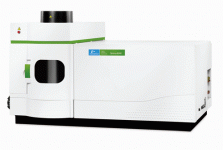Spectrometer specifications
- Double spectrometer: The Optima 8000 ICP-OES uses a unique double-spectrometer optical system. This design results in a high-speed, high light-throughput optical system offering excellent resolution, all in a compact system. The sealed optical system can be purged with nitrogen for low UV (160-190 nm) performance.
- Echelle spectrometer: The high-dispersion echelle spectrometer has a focal length of 0.3 meter and a Stigmatic Littrow configuration. The echelle grating used for dispersion has 79 lines/mm with a blaze angle of 63.4 degrees.
- Parameters: The spectral range is 160-900 nm with resolution of < 0.009 nm @ 200 nm.
- Plasma viewing: The system includes complete dual-viewing optics under computer and software control. Any wavelength can be used in the radial, axial or mixed viewing modes in a single method. With the patented dual-view capabilities of the Optima 8000 system, viewing of the plasma is accomplished by computer control of a mirror located in the optical path and allows selection of axial or radial view and adjustment of the plasma viewing in both the vertical and horizontal planes.
- Detector: The UV-sensitive, dual backside-illuminated Charge-Coupled Device (CCD) array detector is cooled directly using a single-stage integrated Peltier cooler operated at approximately -8 °C. The detector has two photosensitive segments containing 176 by 128 pixels. One section is used for analy tical measurements, and the other is a wavelength reference section. The CCD-array detector collects both the analyte spectra and the nearby background spectra, allowing for simultaneous background correction and providing improved precision and analytical speed.
- Dynamic Wavelength Stabilization™: The wavelength reference section of the detector monitors a full wavelength neon spectrum, creating a dynamic wavelength scale used to actively correct wavelength positions. The resulting wavelength accuracy and reproducibility allows direct ‘on-peak’ measurements rather than time-consuming peak-search methods used in sequential ICP systems.
ICP system specifications
- RF generator: The Optima 8000 features a fourth-generation 40 MHz, free-running solid-state RF generator, adjustable from 750 to 1500 watts, in 1 watt increments. The power efficiency is greater than 81% with < 0.1% variation in output power stability. True Power Control maintains the plasma power at the set point, even when changing sample matrices. The compact RF supply meets all FCC certification requirements for RF emission (Part 18 of FCC rules and regulations) and complies with EC and VDE 0871 Class B requirements.
- Ignition and power control: Plasma ignition is computer-controlled and totally automated. The plasma can be ignited automatically at a user-determined time and turned off automatically after an analysis.
- Safety interlocks: For user safety and system protection, the system constantly monitors water flow, shear gas pressure, argon pressures, sample-compartment door closure and plasma stability, and displays the interlock status on the computer screen as graphic symbols. If an interlock is interrupted, the plasma will immediately and safely shut down.
- Cooling water: A water-recirculating cooling system is required, with approximately 4 L/min flow capacity at 310 to 550 kPa and a temperature between 15 °C and 25 °C.
Gas flow controls
- Argon flow: Computer-controlled solenoid valves are used to regulate the flow automatically within the range of 0-20 L/min in 1 L/min increments for plasma argon and 0 to 2.0 L/min in 0.1 L/min increments for auxiliary argon. A mass-flow controller is supplied with all systems for the nebulizer argon flow and is variable between 0 and 2.0 L/min in 0.01 L/min increments.
- Shear gas: A compressed-air shear gas (18-25 L/min) is used to remove the plasma tail from the optical path, minimizing interferences and extending the dynamic range. The shear gas design offers a maintenance-free and lower-cost approach to removing the cooler plasma zone.
Sample introduction system
- Torch/torch mount: A unique, demountable torch design using one-piece quartz tubing for plasma and auxiliary gas flow is supplied. The standard torch includes a 2.0-mm i.d. alumina injector for full corrosion resistance to all acids, including hydrofluoric and aqua regia. A variety of other injectors is available. The externally mounted spray chamber is integrated into an easily removed sample-introduction cassette in an enclosed compartment. The sample-introduction cassette can be adjusted (with the plasma on) for maximum performance in different matrices. No tools are required for torch or sample-introduction cassette removal.
- Spray chambers: Instruments can be ordered with a Ryton® HF-resistant Scott-type or a glass cyclonic spray chamber. An optional spray-chamber compartment thermostat is available for laboratories with minimal air conditioning.
- Nebulizers: The Optima 8000 can be ordered with a cross-flow or glass concentric nebulizer. The cross-flow design with GemTips™ is corrosion-resistant (sapphire/ruby tips in a PEEK body). The system can routinely handle 50% (v/v) solutions of HCl, HNO3, H2SO4, H3PO4, 20% (v/v) HF and 30% (w/v) NaOH. Additional nebulizers are available. A model of the Optima 8000 is available with eNeb™ sample introduction, which provides highly efficient and consistent sample transport, resulting in a 2-4x improvement in detection limits.
- Peristaltic pump: The integrated three-channel, computer-controlled pump has variable speeds from 0.2 to 5 mL/min in 0.1 mL/min increments, using 0.76 mm (0.030 in.) i.d. tubing. Software features include FastPump™ and SmartRinse™, which dramatically improve the sample rinse-out and analysis times.
- Spares kit: A spares kit of common replacement items is included.
Physical data – instrument
- Power: One 200-254 VAC, 20A line (12A draw at 230 V), single phase, 50/60 Hz (±1%)
- Dimensions: 132 x 81 x 76 cm (W x H x D), 132.5 kg
- Environmental: The instrument will operate with a laboratory temperature between 15 and 35 °C (59-95 °F). For optimum instrument performance, the room temperature should be controlled at 20 ±2 °C.









 Print
Print Sent by email
Sent by email



